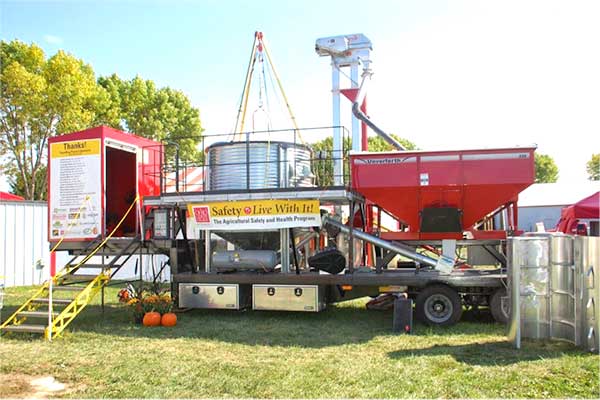|
|
 |
|

|
Grain Safety
Awareness Program to be held
By Sam Custer
OSU Extension, Darke County
On June 14, the Darke County Farm Safety Just For Kids program will be
held at the Darke County Fairgrounds.
Demonstrations using the Grain C.A.R.T. (Community Agricultural Rescue
Trailer) — Ohio’s first portable grain rescue simulator will be done.
When working around grain storage facilities, incidents such as slips,
trips, falls, severe trauma injuries, entanglement or engulfment can
happen in a fraction of a second, said Sam Custer, Darke County
Agriculture and Natural Resources Educator for Ohio State University
Extension. OSU Extension is the outreach arm of the College Food,
Agricultural, and Environmental Sciences at The Ohio State University.
Designed by CFAES faculty and students, the Grain C.A.R.T. is mounted
on a 40-foot flatbed trailer and includes a grain bin, grain leg,
gravity wagon and other training essentials.
Demonstrations for the general public and first responders will be held
between 3:30 and 5:30 on the 14th of June. Everyone who has or
may have contact with grain handling equipment or facilities should
plan to attend.
The Grain C.A.R.T. is used statewide by the Ohio Fire Academy in its
agricultural rescue direct-delivery training modules to educate first
responders on grain bin engulfment.
It’s also being used with OSU Extension’s grain bin rescue outreach
education program in rural communities to raise awareness among grain
industry employees and farm families about the hazards associated with
grain handling, he said.
“Throughout Ohio, on-farm grain storage facilities are being
upgraded, and newly constructed on-farm storage facilities are getting
larger and larger,” Custer said.
It is important for people to think about the safety issues involved
when handling grain throughout the fall and winter months. A lot of
farmers recognize the hazards associated with handling grain, but
during a busy harvest season, safety may not always be at the forefront
of their work process.
A farmer working alone at an on-farm grain storage facility is a common
safety shortcut, he said.
“It’s always a good idea to notify family members or coworkers before
starting any potentially dangerous work and tell them when you expect
to finish,” Custer said. “If you are supposed to be done within a
specific time, someone can check on you periodically or if you are
late.”
Other safety tips include:
Keep equipment properly maintained. Recognize, respect and avoid
equipment hazards such as cut points, wrap points, pinch points, burn
points and stored energy. Severe injuries from equipment hazards can
happen in a fraction of a second.
Emergency contact information and procedures should be available and
verified. Make sure cell phones are adequately charged and have signal
before starting potentially dangerous work.
Know where overhead power lines are so they can be avoided when moving
equipment or using a portable auger.
Make sure there is adequate lighting at the facility when working in
low light conditions to prevent slips, trips and falls.
Have a fire extinguisher handy and charged. A fire in its beginning
stages often can be extinguished by a quick response by someone with a
fire extinguisher.
Wear an N-95 respirator when working around grain, as it keeps 95
percent of the dust and other pollutants from the grain from entering
the lungs.
All equipment shutoffs should be labeled in the electrical panel and at
switches. This makes it easier to shut off specific equipment in the
event of an emergency.
Never enter a grain bin when the unloading equipment is on. Lockout or
tagout procedures should be developed for all equipment to keep them
from being unexpectedly started.
Never enter a grain bin alone. If entry into the bin is necessary,
always have at least one observer outside the bin, and make sure all
augers are turned off. One person is to enter the bin, and the others
should remain outside in case an emergency occurs. Always use a body
harness with a lifeline secured to the outside of the bin.
Bridged grain or grain lining the wall of the bin is dangerous and
should be handled at a distance.
Use a pole to break up bridged grain, and try pounding on the outside
of the bin to dislodge grain that clings to bin walls.
If the grain is out of condition, poisonous gases may accumulate. If
you suspect that the air inside the bin is unsafe, do not try to enter
without first sampling the air.
Offering these tips are just one way the college’s Agricultural Safety
and Health program works to provide grain safety awareness to growers.
It also offers grain safety demonstrations and awareness training for
farm families, 4-H youth, agricultural employees and rural communities,
Custer said.
More information on scheduling grain safety awareness programs can be
found at agsafety.osu.edu/grain-cart/scheduling.
For more information about OSU Extension, Darke County, visit the Darke
County OSU Extension web site at www.darke.osu.edu or the OSU Extension
Darke County Facebook page.
|
|
|
|

